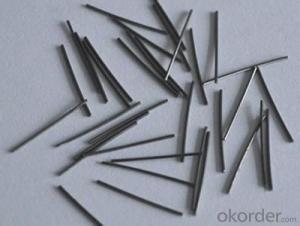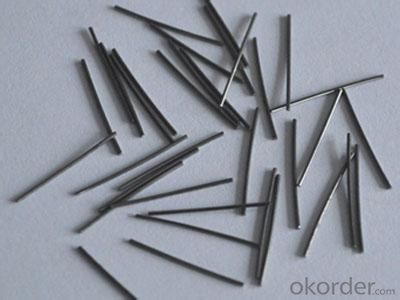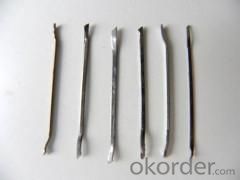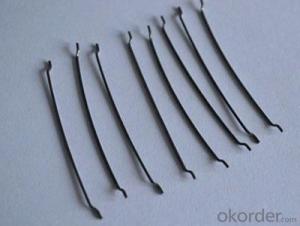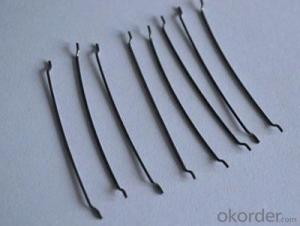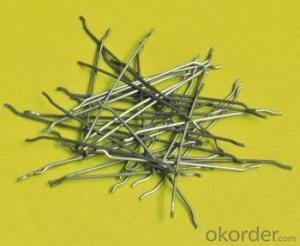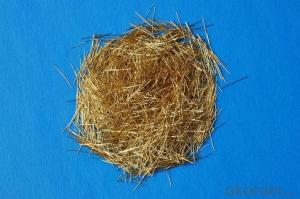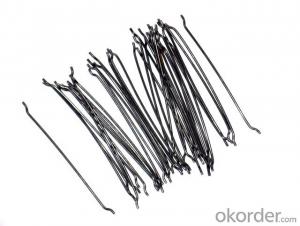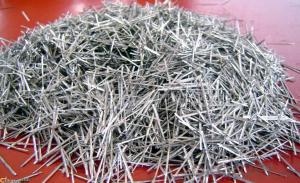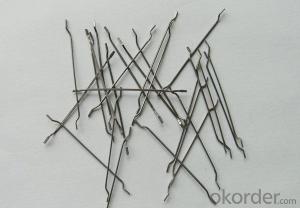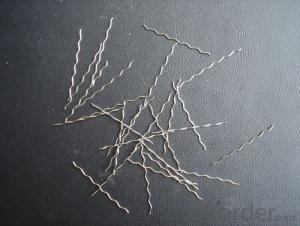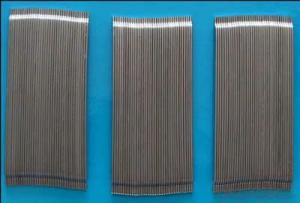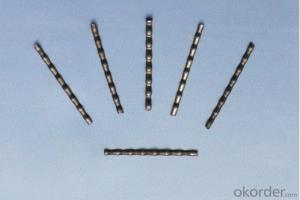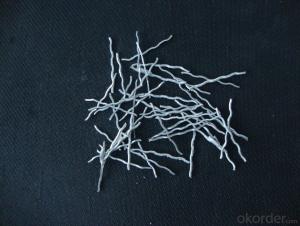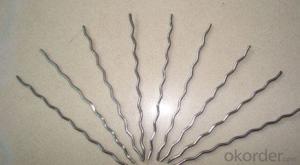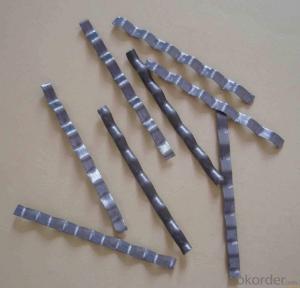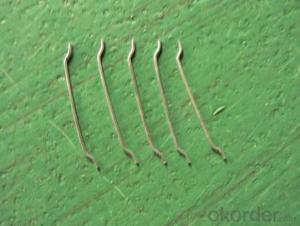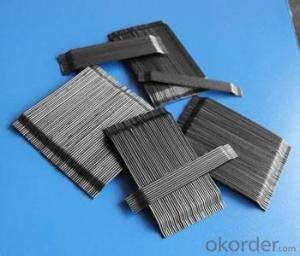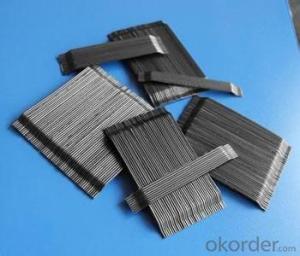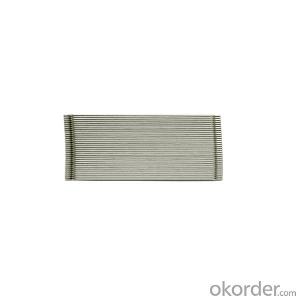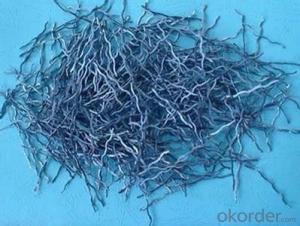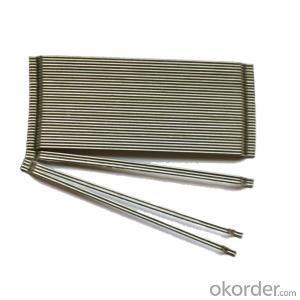Melt Extract Stainless Steel Fiber Reinforced Concrete with Admixtures
- Loading Port:
- Tianjin
- Payment Terms:
- TT OR LC
- Min Order Qty:
- 1000 kg
- Supply Capability:
- 250000 kg/month
OKorder Service Pledge
OKorder Financial Service
You Might Also Like
Quick Details
Place of Origin: Shandong, China (Mainland), Shandong, China (Mainland)
material: steel wire
type: wavy steel fiber
shape: corrugated flat fiber
usage: concrete reinforcement
appearance: clear and bright
Product features
steel fiber are for concrete construction, greatly improves concrete bonding and tensile strength .
The steel fiber is made of high-quality low carbon steel wire,with the characteristic of the high tensile strength,good toughness,etcs.This product is widely used in the construction fields for concrete reinforcement
or the shotcrete for tunnle.According to the standard of JG/T3046-1999 Steel Fiber Concrete, YB/T 151-1999 Steel Fiber for Concrete and ASTM AB820-90 Steel Fiber for the Fiber-Rinforced Concrete.
Specifications
| The Specification of Hooker Ends Steel Fiber | ||||
| TYPE | Diameter(mm) | Length(mm) | Length/Diameter | Tensile strength |
| LB-60/60 | 1.0 | 60 | 60 | >=1000Mpa |
| LB-50/50 | 1.0 | 50 | 50 | >=1000Mpa |
| LB-65/60 | 0.9 | 60 | 65 | >=1000Mpa |
| LB-55/50 | 0.9 | 50 | 55 | >=1000Mpa |
| LB-80/60 | 0.75 | 60 | 80 | >=1000Mpa |
| LB-45/35 | 0.75 | 35 | 45 | >=1000Mpa |
| LB-55/30 | 0.55 | 30 | 55 | >=1000Mpa |
| LB-60/30 | 0.5 | 30 | 60 | >=1000Mpa |
| LB-50/25 | 0.5 | 25 | 50 | >=1000Mpa |
| LB-60/25 | 0.4 | 25 | 60 | >=1000Mpa |
Picture
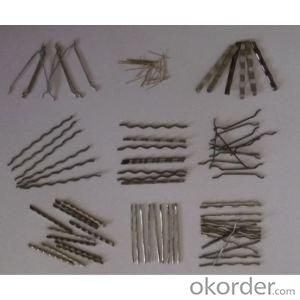
steel fiber for concrete reinforcement
FAQ
we can produce any type steel fiber and of course we can make production according to your requirement
we have specilize in this field for almost 10 years ,with good quality and competitive price
- Q: Can melt extract stainless steel fiber be used in sports field pavements?
- Yes, melt extract stainless steel fiber can be used in sports field pavements. Stainless steel fibers are known for their high strength and durability, making them an excellent choice for applications that require resistance to wear and heavy traffic, such as sports field pavements. These fibers can improve the overall performance and lifespan of the pavement by enhancing its toughness, crack resistance, and fatigue resistance. Additionally, the corrosion resistance of stainless steel ensures that the fibers will not deteriorate over time, even in harsh weather conditions. Overall, using melt extract stainless steel fiber in sports field pavements can help create a more robust and long-lasting surface that can withstand the rigorous demands of sports activities.
- Q: Can melt extract stainless steel fiber be used in basement walls?
- Yes, melt extract stainless steel fiber can be used in basement walls. It is commonly used as a reinforcement material to improve the structural integrity and durability of concrete. The stainless steel fibers enhance the flexural and tensile strength of the concrete, making it an ideal choice for basement walls that require added strength and resistance to cracking.
- Q: How does the size and shape of melt extract stainless steel fiber affect its performance?
- The performance of melt extract stainless steel fiber is greatly influenced by its size and shape in different applications. Firstly, the fiber's surface area and volume are impacted by its size, which in turn affects its bonding strength with other materials. Smaller fibers generally have a larger surface area, allowing for stronger adhesion and better reinforcement of composite materials. Furthermore, the fiber's mechanical properties, such as tensile strength and ductility, are also influenced by its size. Smaller fibers tend to have higher tensile strength and increased flexibility, making them suitable for applications requiring improved structural integrity and resistance to deformation. Additionally, the performance of melt extract stainless steel fiber is dependent on its shape. Fibers with irregular or jagged shapes exhibit enhanced interlocking capabilities, enabling them to provide better mechanical anchorage within the matrix material. This improved interlocking mechanism enhances the fiber's ability to distribute stress and resist crack propagation, thereby increasing the overall durability and toughness of the composite material. On the other hand, fibers with a more regular or smooth shape offer advantages in terms of flowability and dispersibility during the manufacturing process. These fibers tend to exhibit better homogeneity and uniform distribution within the matrix material, resulting in improved mechanical properties and overall performance. In conclusion, the performance of melt extract stainless steel fibers is significantly influenced by their size and shape. Manufacturers can optimize the fiber's bonding strength, mechanical properties, and overall effectiveness in various applications, such as reinforcement in concrete, thermal insulation, or electrical conductivity, by carefully selecting the appropriate size and shape.
- Q: Can melt extract stainless steel fiber be used in airport runway construction?
- Yes, melt extract stainless steel fiber can be used in airport runway construction. Stainless steel fiber is known for its high strength and durability, making it suitable for heavy-duty applications such as airport runways. It helps to enhance the overall performance and lifespan of the runway by providing reinforcement and reducing cracking. Stainless steel fibers also have excellent resistance to corrosion, which is crucial for withstanding the harsh environmental conditions experienced in airport settings. Additionally, the use of stainless steel fibers can help improve the skid resistance of the runway surface, ensuring safer landings and takeoffs for aircraft.
- Q: Can melt extract stainless steel fiber be used in high-strength shotcrete applications?
- Yes, melt extract stainless steel fiber can be used in high-strength shotcrete applications. This type of fiber provides enhanced strength and durability to the shotcrete, making it suitable for demanding applications that require high-strength materials.
- Q: How does melt extract stainless steel fiber improve the ductility of shotcrete?
- The ductility of shotcrete is enhanced by melt extract stainless steel fiber, which improves its resistance to deformation and cracking. The inclusion of stainless steel fibers in the shotcrete mix forms a reinforced matrix that increases its tensile strength and flexural capacity. During the application of shotcrete, it undergoes a curing process that results in hardening and increased strength. However, shotcrete is susceptible to cracking when subjected to tensile stresses without any reinforcement. By integrating melt extract stainless steel fibers, the ductility of shotcrete is enhanced as the fibers distribute the tensile forces throughout the material, preventing the formation and spread of cracks. The exceptional properties of stainless steel, such as its high tensile strength and corrosion resistance, make it an ideal material for reinforcing shotcrete. The fibers are evenly dispersed within the shotcrete mix, creating a three-dimensional reinforcement system that improves its structural integrity. The addition of stainless steel fibers also enhances the overall durability of shotcrete. The fibers act as a barrier, preventing the entry of water and other harmful substances, thereby reducing the risk of corrosion and deterioration. This results in a longer service life and reduces the need for expensive maintenance and repairs. In conclusion, the presence of melt extract stainless steel fiber enhances the ductility of shotcrete by reinforcing its structure and improving its ability to withstand tensile stresses and deformation. Incorporating these fibers provides shotcrete with increased strength, durability, and resistance to cracking, ultimately enhancing its performance and extending its lifespan.
- Q: What is the effect of melt extract stainless steel fiber on the autogenous shrinkage of concrete?
- The addition of melt extract stainless steel fibers to concrete can significantly reduce the autogenous shrinkage. These fibers act as reinforcement, helping to distribute the internal stresses and restrain the shrinkage of the concrete. This leads to a decrease in the overall shrinkage of the concrete, resulting in improved durability and reduced cracking potential.
- Q: How does melt extract stainless steel fiber affect the fire resistance of concrete?
- Concrete's fire resistance is significantly improved by the inclusion of melt extract stainless steel fibers. These fibers, composed of a high-grade stainless steel alloy, possess unique properties that enable them to withstand extremely high temperatures while maintaining their structural integrity. Consequently, when exposed to fire, these stainless steel fibers act as reinforcements, preventing the concrete from cracking or spalling due to thermal stress. Moreover, the presence of stainless steel fibers enhances the concrete's thermal conductivity. This results in a more efficient dissipation of heat throughout the concrete during a fire, reducing the risk of localized hotspots that could compromise the material's structural stability. Furthermore, melt extract stainless steel fibers contribute to the overall durability and strength of the concrete. By forming a three-dimensional matrix within the material, they enhance its resistance to cracking and deformation caused by heat. In conclusion, the incorporation of melt extract stainless steel fibers into concrete significantly improves its fire resistance. These fibers provide reinforcement, enhance thermal conductivity, and increase the overall durability of the material. As a result, including stainless steel fibers in concrete mixtures is a reliable and effective approach for enhancing the fire resistance of concrete structures.
- Q: How does melt extract stainless steel fiber affect the shrinkage of concrete?
- Melt extract stainless steel fiber can significantly reduce the shrinkage of concrete. The fibers act as reinforcement within the concrete matrix, restraining the movement and cracking caused by shrinkage. This results in a more durable and crack-resistant concrete structure.
- Q: What is the impact of melt extract stainless steel fiber on the shrinkage of concrete?
- The shrinkage of concrete can be significantly affected by the utilization of melt extract stainless steel fiber. To strengthen the concrete and prevent cracking, stainless steel fibers are commonly added to concrete mixes. During the curing process, concrete tends to shrink as water evaporates, leading to cracks and decreased structural durability. However, the inclusion of melt extract stainless steel fibers in the concrete mix effectively controls and minimizes shrinkage. These stainless steel fibers act as reinforcement within the concrete, promoting a more even distribution of stress and strain. This reinforcement restrains concrete shrinkage and provides greater resistance against cracking. The enhanced tensile strength of the concrete also limits overall shrinkage, resulting in a stronger and longer-lasting structure. Furthermore, the melt extract stainless steel fibers possess high corrosion resistance, further enhancing their effectiveness in mitigating shrinkage. This corrosion resistance ensures the fibers maintain their structural integrity over time, even in harsh environmental conditions. Overall, the integration of melt extract stainless steel fibers in concrete significantly reduces shrinkage and improves the material's overall performance. By minimizing cracking and enhancing durability, structures constructed with this type of concrete exhibit a longer lifespan and require less maintenance.
Send your message to us
Melt Extract Stainless Steel Fiber Reinforced Concrete with Admixtures
- Loading Port:
- Tianjin
- Payment Terms:
- TT OR LC
- Min Order Qty:
- 1000 kg
- Supply Capability:
- 250000 kg/month
OKorder Service Pledge
OKorder Financial Service
Similar products
Hot products
Hot Searches
Related keywords
